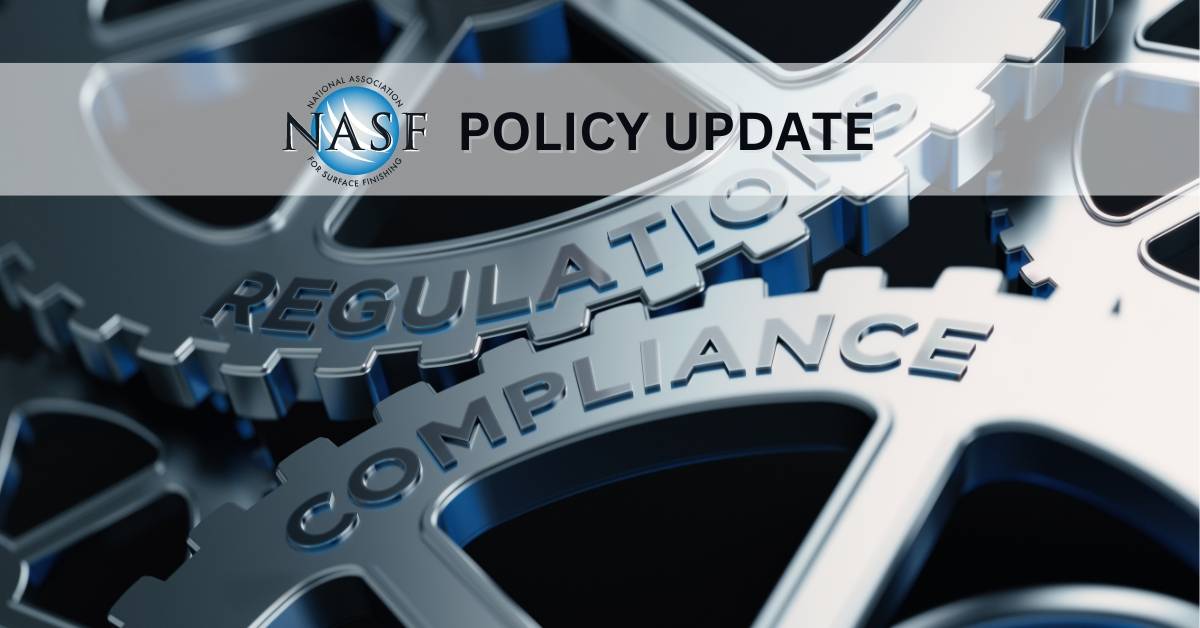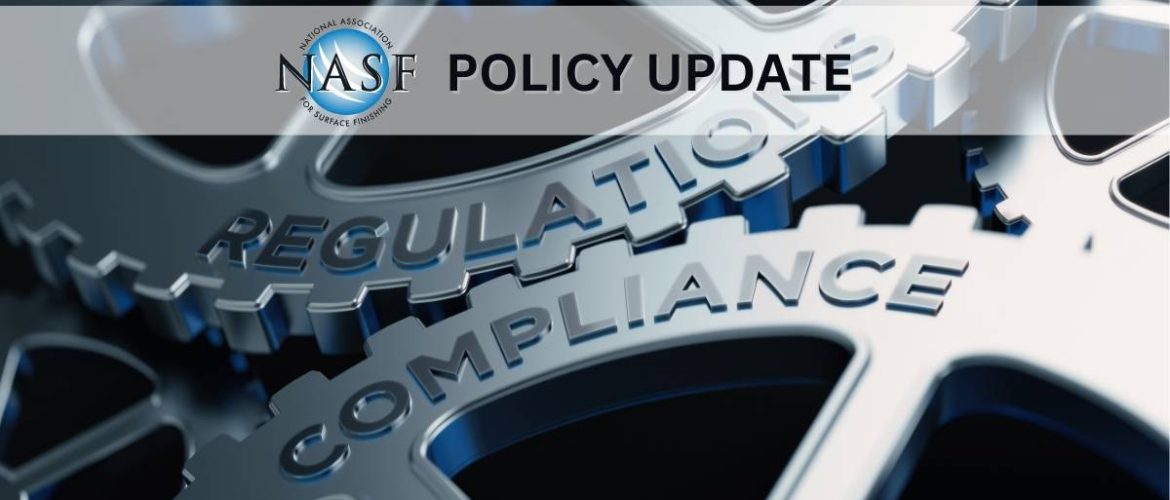
NASF July 2023 Policy Update, news, and important information you need to know to stay current with the National Association for Surface Finishing and our industry.
Government & Industry Affairs Webinar | AESFF Courses | NASF Membership
As the summer winds down, the finishing industry continues faces new regulatory and legislative challenges from the Biden administration, Congress, states and advocacy groups. This month’s update highlights new regulations from OSHA, scientific reviews of PFAS studies, the upcoming regulatory agenda, environmental justice developments, and the NASF Washington Forum scheduled for October 2023. Provided below are summaries of these key issues and their impact on the surface finishing industry.
Federal OSHA has released a final rule requiring employers in certain high-hazard fields to electronically submit annually their OSHA injury and illness logs for the agency to post in summary form on its website.
The new regulation imposes the new compliance obligation on larger establishments (100 or more employees), Information required for submittal to OSHA includes:
- Form 300 Log of Work-Related Injuries and Illnesses (OSHA 300 Log); and
- Form 301 Injury and Illness Incident Reports to OSHA.
The industries covered by the new rule include:
- manufacturing (e.g., surface finishing operations),
- construction,
- health care,
- retail,
- warehousing,
- transportation, and
- performing arts.
Reporting will being in 2024, with March 2, 2024 as the first submission deadline for the new information required to be submitted under the rule.
Data Will be Publicly Accessible
In addition to the new compliance requirements, OSHA has indicated that it intends to publish the data online for public access, although information related to identifying employees, such as names and contact information, will not be publicly released or released through Freedom of Information Act (FOIA) requests.
Information related to the number of injuries at a worksite and nature of those injuries, however, will be freely available to current and potential customers, union organizers, current and potential employees, and plaintiff’s lawyers.
OSHA states that it will seek to minimize the possibility of the release of information by:
- limiting the worker information collected,
- designing the collection system to provide extra protections for some of the information that employers will be required to submit,
- withholding certain fields from public disclosure, and
- using automated software to identify and remove information that could reasonably be expected to identify individuals directly.
In light of the new compliance obligations, as well as the potential exposure employers may face from the new rule, companies should consult with employment experts and develop strategies in addressing how to minimize the instances of recordable injuries or illnesses at the workplace, as well as ensuring all required OSHA records are properly kept.
More information on this rule is available on the OSHA website at: Recordkeeping – Overview | Occupational Safety and Health Administration (osha.gov). If you have any questions or would like additional information, please contact Jeff Hannapel or Christian Richter with NASF at jhannapel@thepolicygoup.com or cichter@thepolicygroup.com.
As the surface finishing industry faces on the first nationwide PFAS discharge rules tailored to a specific industry, a controversial new critical review of existing research on per- and polyfluoroalkyl substances (PFAS) has found that most PFAS studies to date include insufficient data to draw accurate conclusions about the association of PFAS with any specific disease.
The study was featured in the latest issue of Environmental Research, a peer-reviewed environmental science and environmental health journal. It was performed by the Center of Environmental Food and Toxicological Technology at the University of Rovira i Virgili in Spain.
It provides key insight for improving methodological protocols for future PFAS experimental studies and was performed in accordance with the most rigorous set of internationally accepted criteria guiding the reporting of systematic reviews and meta-analyses.
The findings of this critical review may surprise many outside of the scientific community. The researchers found that the most impactful studies on PFAS—those cited most often by regulators and legislators in the United States and worldwide for policy and rulemaking—lack sufficient evidence to draw accurate conclusions about the association of PFAS with any specific disease.
Study Recommendations
A central recommendation from the authors is the need for additional specific research to properly calculate human-relevant dose to further link associations with human risk assessment and help set a tolerable daily intake level.
This is the first review where highly referred articles on PFAS used for policymaking by several regulatory agencies were collected and evaluated based on the review guidelines developed by the U.S. National Toxicology Program’s (NTP) Office of Health Assessment and Translation review guidelines.
Timing for Impacting Regulation
According to the article, the findings come at a critical time, as EPA moves to implement its PFAS Roadmap and new regulatory requirements for PFAS and states take PFAS regulation into their own hands. Rigorous, sound scientific studies must precede any expansive regulatory action on PFAS. They could also lead to more fair and consistent policies that may help protect first responders and consumers and that allow innovation to occur without raising unnecessary alarms.
While noteworthy, the findings in this scientific review are unlikely to slow the momentum of new regulatory requirements to address the impact of PFAS on the environment and public health. Some regulations are based on fairly well-established studies that have linked PFOS and PFOA to specific adverse health effects.
Approach to Future PFAS Regulation
Furthermore, significant data gaps do exist for many of the other PFAS substances, but regulators have taken a precautionary approach to regulating these substances. This new critical review of PFAS studies could, however, deter regulators from addressing all PFAS as a class, and force them to make policy decisions based on chemical specific environmental and health impacts.
As PFAS regulations and new scientific studies continue to evolve, this critical review could help to shape the policy landscape for PFAS. If you have any questions or would like more information regarding this issue, contact Jeff Hannapel or Christian Richter with NASF at jhannapel@thepolicygroup.com or crichter@thepolicygroup.com.
As we noted in the June NASF Policy Report, the White House released its 2023 Spring Regulatory Agenda on June 13, 2023. A copy of the regulatory agenda is available at: Current Unified Agenda of Regulatory and Deregulatory Actions (reginfo.gov).
By June 1, 2023, the Biden Administration has as many federal rulemakings in progress that it did for all of 2022. 343 new rules have been added since January 2023, and nearly 200 of these have been determined to have a significant impact on small business.
In particular, the Biden Administration has embarked on an unprecedented environmental regulatory agenda. Despite the fact that it is one of the smaller federal agencies, EPA ranks sixth among federal agencies in the number of regulations in progress — more than the Departments of Defense, Agriculture, Justice and Energy.
Over the past two years, the Administration has increased the number of significant environmental regulatory actions by nearly 20 percent compared to previous years. President Biden has requested a 19 percent budget increase to address its environmental priorities and to restore EPA staff for its expansive agenda on a wide range of environmental, chemicals management, climate, and environmental justice issues.
The surface finishing industry can expect a range of potential new regulatory requirements to impact its operations over the next two years, particularly as the Biden Administration attempts to finalize regulations before a possible change in administrations at the end of 2024.
In an important legal case affecting manufacturers, environmental justice and community groups have alleged discrimination in the State of Louisiana’s permitting practices and their potential impact on communities in area well known as “Cancer Alley.”
The allegations cited the Civil Rights Act of 1964 and claimed that state permits were discriminatory by allowing facilities to release harmful chemicals into the environment impacting the health of overburdened communities. EPA initiated an investigation into the allegations.
In the meantime, the State of Louisiana filed a lawsuit and challenged EPA’s probe as unconstitutional and lacking statutory authority. EPA concluded its investigation with a finding of no discrimination.
These developments call into question federal authority to enforce environmental justice without a formal finding of discrimination under the Civil Rights Act of 1964 and could impact EPA’s ability to enforce major initiatives in the future.
While this legal action is significant for federal environmental justice initiatives, it may not be enough to alter the momentum of federal environmental justice programs. In addition, some states have their own state authorities to enforce environmental justice initiatives. If you have any questions or would like more information regarding this issue, contact Jeff Hannapel or Christian Richter with NASF at jhannapel@thepolicygroup.com or crichter@thepolicygroup.com.
The 2023 NASF Washington Forum will be held October 30 – November 1, 2023 at the Ritz Carlton, Pentagon City, 1250 S. Hayes St., Arlington, VA 22202. Make your plans to attend this high value event now!
The Forum includes presentations and briefings from national and global experts on pertinent policy, technical, regulatory, and management issues impacting the surface finishing industry, including environmental regulatory issues, labor and workplace trends, tax policy, economic forecasting, supply chain challenges, globally regulatory developments and election commentary.
In addition, Washington Forum Participants also have the option during the event to meet with their own congressional representatives and staff to educate them about the importance and impact of the surface finishing industry, the challenges facing their companies and specific policy priorities of concern. For information on registering for the Washington Forum, contact NASF at (202) 591-2454 or info@nasf.org.
NASF 1000
The sustained commitment from industry leaders has helped the NASF remain strong and credible in informing regulatory decisions across the nation. Specific projects funded through the NASF 1000 make a measurable difference in how the industry navigates emerging challenges, communicates credibly with policy makers, and advocates for a strong science base for rules or standards that affect surface finishing.
Please consider supporting the NASF 1000 program. If you have any questions or would like additional information regarding the NASF 1000 program or the broad array of NASF public policy activities, please contact Jeff Hannapel with NASF at jhannapel@thepolicygroup.com.









